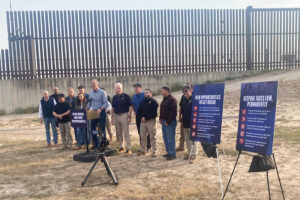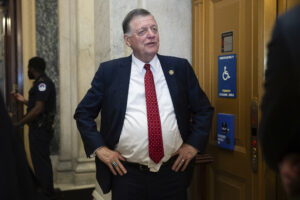The Dictatorship
Jared Kushner is about to shred whatever’s left of his diplomatic reputation

President Donald Trump’s son-in-law Jared Kushner, along with former British Prime Minister Tony Blairbriefed the White House late last month on a plan for postwar Gaza, NBC News, citing two White House officials, reported last week. The proposal, to put it plainly, is an unserious, politically ignorant, economic-centric pipe dream, a la Trump’s vision of a “ Gaza Riviera.” And it further highlights Kushner’s decidedly overrated reputation as a successful diplomat in Middle East relations.
First reported by The Washington Postwhich also published the document in full, the “GREAT* Trust (*Gaza Reconstitution, Economic Acceleration and Transformation)” prospectus includes graphics that envision rolling green hills and skyscrapers standing on what’s currently a wasteland of destruction and starvation. It provides a glossy sheen to ethnic cleansing and places no responsibility on Israel to make meaningful steps toward a political solution that ends the larger conflict — including Palestinian self-determination in Gaza.
It further highlights Kushner’s decidedly overrated reputation as a successful diplomat in Middle East relations.
Despite being presented to the White House by a former U.K. prime minister and the president’s son-in-law — whose investment firm has received billions in investments and fees from the governments of the United Arab Emirates, Qatar and Saudi Arabia — it’s unclear if this plan is what the Trump White House has in mind, as the White House didn’t respond to BLN’s request for comment on the matter. It’s also not clear what, if any, involvement Kushner had in creating the “GREAT Trust” proposal, but the fact that he presented it to the White House telegraphs at least some support.
The plan sees Gaza (not Hamas, but Gaza itself) as “an Iranian outpost in a moderate part of the region,” but also a potential “Abrahamic Ally,” which appears to be a reference to the “Abraham Accords,” the 2020 agreements that normalized relations between Israel and several Arab countries, and which were brokered by Kushner during the first Trump administration. According to the plan, the trust will govern Gaza “for a transition period until a reformed and deradicalized Palestinian Polity is ready to step in its shoes,” adding that the “reformed Palestinian Polity will join the Abraham Accords.”
Lovely idea, but how will that work? Prime Minister Benjamin Netanyahu has long insisted a Palestinian state will “never” happen and has even ruled out the possibility of a future Gaza government led by the Palestinian Authority — the internationally recognized representative of the Palestinian people, which also recognizes Israel’s right to exist, supports a two-state solution and correctly blames Hamas for starting this horrific war.
So how will this “reformed Palestinian Polity” come into existence? The “GREAT Trust” doesn’t have time for such pesky details. The Israeli-Palestinian crisis might be approaching its ninth decade — and a two-state solution has never looked less likely — but this proposal only sees the money to be made. The fate of Gazan civilians is rendered as a minor and temporary impediment to untold economic prosperity.
The plan includes something called “The Elon Musk Smart Manufacturing Zone” and vague references to high-speed rail lines that would connect Gaza with other “Abrahamic” states (presumably referring to the Arab countries that have normalized relations with Israel). But, crucially, the plan aims to have as few Gazans in Gaza as possible.
As The Guardian summarized“Palestinians would be encouraged into ‘voluntary’ departure to another country or into restricted, secure zones during reconstruction. Those who own land would be offered ‘a digital token’ by the trust in exchange for rights to redevelop their property, to be used to finance a new life elsewhere. Those who stay would be housed in properties with a tiny footprint of 323 sq ft — minuscule even by the standards of many non-refugee camp homes in Gaza.”
According to the Post, the proposal “was developed by some of the same Israelis who created and set in motion the U.S.- and Israeli-backed Gaza Humanitarian Foundation (GHF) now distributing food inside the enclave. Financial planning was done by a team working at the time for the Boston Consulting Group,” but “BCG has said that work on the trust plan was expressly not approved and that two senior partners who led the financial modeling were subsequently fired.”
Even though the White House hasn’t said if it supports the GREAT prospectus, the plan does comport with Trump’s previous statements that he wanted to “clean out Gaza” and move people from there to Jordan and Egypt. Trump’s use of “clean out Gaza” was a euphemism for ethnic cleansing that, as I noted in Februaryobliterated any pretense that the U.S. would be an objective mediator in resolving the seemingly intractable conflict.
“If ethnic cleansing is on the table at all, Trump has already done his job. He has not only moved the Overton Window; he has opened it wide for humanity’s worst instincts to become just another political issue, as worthy of consideration and debate as any other,” I wrote at the time. And some of the more extreme members of Netanyahu’s government have been disturbingly candid about the government’s intentions — to make Gaza unlivable, with the hopes that Gazans will submit to “voluntary relocation,” clearing the path for the resettlement of Gaza.
Kushner’s crowning diplomatic achievement, the Abraham Accords, is at risk because of the continued bellicosity of his good friend Benjamin Netanyahu and his government.
Kushner has been hailed by many pro-Israel partisans for his statesmanship, but as a senior adviser in the first Trump administration, his 2020 “Peace to Prosperity” plan leaned so heavily in favor of Israeli interests, it was effectively a nonstarter. At the time, Ilan Goldenberga former State Department official who served as the chief of staff to the special envoy for Israeli-Palestinian negotiations, said the proposed land swaps gave Palestinians “a bunch of desert entirely disconnected from the rest of their state while taking prime real estate in the middle of the West Bank [for Israel].”
And the Abraham Accords — Kushner’s crowning diplomatic achievement — came with one major flaw: Almost nothing was advanced to end the Israeli blockade of Gaza or the occupation of the West Bank, leaving millions of Palestinians under Israeli control, but lacking basic civil rights.
Just days after Hamas’ savage attack on Israel on Oct. 7, 2023, Nicholas Grossman wrote that rather than bringing about the “dawn of a new Middle East,” Trump actually “threw America’s weight behind Israeli Prime Minister Benjamin Netanyahu’s squeeze-and-ignore approach to the Palestinians as if the fundamental problem of people displaced and living under occupation would just go away.” And Hamas has been open about the fact that it launched the Oct. 7 offensive in large part to upend further Israeli-Arab normalization efforts.
Now the UAE, an Abraham Accords signee, has warned the Trump administration that the accords could collapse if Israel goes through with its threatened annexation of large parts of the West Bank in response to several Western countries recognizing a Palestinian state. Axios, citing two Israeli officials, reported Wednesday that Secretary of State Marco Rubio had signaled in private meetings that he wouldn’t oppose such annexations.
Axios quoted a senior Emirati official as saying, “These plans, if carried out, will do substantial damage to the UAE-Israel relationship. And they will irreparably damage whatever remains of the vision of regional integration. In many ways, the choice before Israel right now is annexation or integration.”
At a news conference in Ecuador on Thursday, Rubio said that “as far as what you’re seeing with the West Bank and the annexation, that’s not a final thing. That’s something that’s being discussed among some elements of Israeli politics. … I’m not going to opine on that today. What I am going to tell you is it was wholly predictable.”
Kushner’s crowning diplomatic achievement, the Abraham Accords, is at risk because of the continued bellicosity of his good friend Benjamin Netanyahu and his government. And by presenting the “GREAT Plan” to the White House — which includes plans for the “voluntary” relocation of Gazans to other countries — Kushner himself is putting the Abraham Accords at risk.
Anthony L. Fisher is a senior editor and writer for BLN Daily. He was previously the senior opinion editor for The Daily Beast and a politics columnist for Business Insider.
The Dictatorship
Changes to the US vaccine recommendations are sowing confusion and could harm kids

Dr. Molly O’Shea has noticed growing skepticism about vaccines at both of her Michigan pediatric offices and says this week’s unprecedented and confusing changes to federal vaccine guidance will only make things worse.
One of her offices is in a Democratic area, where more of the parents she sees are opting for alternative schedules that spread out shots. The other is in a Republican area, where some parents have stopped immunizing their children altogether.
She and other doctors fear the new recommendations and the terminology around them will stoke vaccine hesitancy even more, pose challenges for pediatricians and parents that make it harder for kids to get shots, and ultimately lead to more illness and death.
The biggest change was to stop blanket recommendations for protection against six diseases and recommend those vaccines only for at-risk children or through something called “shared clinical decision-making” with a health care provider.
The phrase, experts say, is confusing and dangerous: “It sends a message to a parent that actually there’s only a rarefied group of people who really need the vaccine,” O’Shea said. “It’s creating an environment that puts a sense of uncertainty about the value and necessity or importance of the vaccines in that category.”
Health Secretary Robert F. Kennedy Jr.who helped lead the anti-vaccine movement for years, said in announcing the changes that they better align the U.S. with peer nations “while strengthening transparency and informed consent.”
But doctors say they are sowing doubt — the vaccines have been extensively studied and proven to be safe and effective at shielding kids from nasty diseases — at a time when childhood vaccination rates are already falling and some of those infectious diseases are spreading.
On Friday, the American Academy of Pediatrics and more than 200 medical, public health and patient advocacy groups sent a letter to Congress about the new childhood immunization schedule.
“We urge you to investigate why the schedule was changed, why credible scientific evidence was ignored, and why the committee charged with advising the HHS Secretary on immunizations did not discuss the schedule changes as a part of their public meeting process,” they wrote.
Many don’t know what ’shared decision-making’ means
O’Shea said she and other pediatricians discuss vaccines with parents at every visit where they are given. But that’s not necessarily “shared clinical decision-making,” which has a particular definition.
On its website, the Advisory Committee on Immunization Practices says: “Unlike routine, catch-up, and risk-based recommendations, shared clinical decision-making vaccinations are not recommended for everyone in a particular age group or everyone in an identifiable risk group. Rather, shared clinical decision-making recommendations are individually based and informed by a decision process between the health care provider and the patient or parent/guardian.”
In this context, health care providers include primary care physicians, specialists, physician assistants, nurse practitioners, registered nurses and pharmacists.
A pair of surveys conducted last year by the Annenberg Public Policy Center at the University of Pennsylvania suggested that many people don’t fully understand the concept, which came up last year when the federal government changed recommendations around COVID-19 vaccinations.
Only about 2 in 10 U.S. adults knew that one meaning behind shared decision-making is that “taking the vaccine may not be a good idea for everyone but would benefit some.” And only about one-third realized pharmacists count as health care providers to talk with during the process, even though they frequently administer vaccines.
As of this week, vaccines that protect against hepatitis A, hepatitis B, rotavirus, RSV, flu and meningococcal disease are no longer universally recommended for kids. RSV, hepatitis A, hepatitis B and meningococcal vaccines are recommended for certain high-risk populations; flu, rotavirus, hepatitis A, hepatitis B and meningococcal vaccines are recommended through shared decision-making — as is the COVID-19 vaccine, although that change was made last year.
Shortly after the federal announcement Monday, Dr. Steven Abelowitz heard from half a dozen parents. “It’s causing concern for us, but more importantly, concern for parents with kids, especially young kids, and confusion,” said Abelowitz, founder of Ocean Pediatrics in Orange County, California.
Though federal recommendations are not mandates — states have the authority to require vaccinations for schoolchildren — they can affect how easy it is for kids to get shots if doctors choose to follow them.
Under the new guidelines, O’Shea said, parents seeking shots in the shared decision-making category might no longer bring their kids in for a quick, vaccine-only appointment with staff. They’d sit down with a health care provider and discuss the vaccine. And it could be tougher to have a flu clinic, where parents drive up and kids get shots without seeing a doctor.
Staying the course as challenges mount
Still, doctors say they won’t let the changes stop them from helping children get the vaccines they need. Leading medical groups are sticking with prior vaccine recommendations. Many parents are, too.
Megan Landry, whose 4-year-old son Zackary is one of O’Shea’s patients, is among them.
“It’s my responsibility as a parent to protect my child’s health and well-being,” she said. “Vaccines are a really effective and well-studied way to do that.”
She plans to keep having the same conversations she’s always had with O’Shea before getting vaccines for Zackary.
“Relying on evidence and trusted medical guidance really helps me to make those decisions,” she said. “And for me, it’s not just a personal choice for my own son but a way to contribute to the health of everybody.”
But for other families, confidence about vaccines is waning as trust in science erodes. O’Shea lamented that parents are getting the message that they can’t trust medical experts.
“If I take my car to the mechanic, I don’t go do my own research ahead of time,” she said. “I go to a person I trust and I trust them to tell me what’s going on.”
Abelowitz, the California doctor, likened the latest federal move to pouring gasoline on a fire of mistrust that was already burning.
“We’re worried the fire’s out of control,” he said. “Already we’ve seen that with measles and pertussis, there are increased hospitalizations and even increasing deaths. So the way that I look at it — and my colleagues look at it — we’re basically regressing decades.”
___
The Associated Press Health and Science Department receives support from the Howard Hughes Medical Institute’s Department of Science Education and the Robert Wood Johnson Foundation. The AP is solely responsible for all content.
The Dictatorship
U.S. launches fresh strikes on ISIS targets in Syria

The U.S. has carried out “large-scale strikes” against multiple Islamic State targets in Syria along with partner forces, U.S. Central Command said on Saturday.
The attack is a part of an operation launched on Dec. 19, when U.S. forces struck “more than 70 targets” in central Syria as retaliation for the killing of three Americans by an ISIS gunman in early December.
“The strikes today targeted ISIS throughout Syria as part of our ongoing commitment to root out Islamic terrorism against our warfighters, prevent future attacks, and protect American and partner forces in the region,” CENTCOM said in a statement.
Tom Barrack, the Trump administration’s special envoy for Syria, announced on Saturday that he met with Syria’s new leadership in Damascus “to discuss recent developments in Aleppo and the broader path forward for Syria’s historic transition.”
The deadly attack in December marked the first fatalities of U.S. troops in the country since former President Bashar al-Assad was ousted last year. Three other U.S. service members were injured in the attack in December, and a state-run news agency reported that two members of the Syrian security forces were also wounded.
President Donald Trump said at the time that the attack by ISIS took place “in a very dangerous part of Syria, that is not fully controlled by them.” He also said Syrian President Ahmed al-Sharaa, whom he had met in November at the White House, was “extremely angry and disturbed by this attack.”
Defense Secretary Pete Hegseth said last month that the operation was “a declaration of vengeance” over the deaths of the American service members.
This is a developing story. Please check back for updates.
Clarissa-Jan Lim is a breaking news reporter for MS NOW. She was previously a senior reporter and editor at BuzzFeed News.
The Dictatorship
When it comes to ICE encounters, what are the rules — and your rights?

In the wake of Renee Nicole Good’s death, Americans are asking, with heightened urgency, what authority ICE and CBP agents have when they engage with U.S. citizens. And as with many areas of the law, the answer is largely, “It depends.”
Can ICE use deadly force on U.S. citizens – or ever?
When it comes to the use of force, and specifically, the use of firearms, ICE has its own specific policy that was last updated in 2023. That policy was filed in the Chicago-area litigation over ICE and CBP’s treatment of protesters, clergy, and journalists. (Interestingly, on ICE’s website, that same policy is almost entirely redacted.) This policy does not vary depending on the subject’s immigration or citizenship status. Here’s what it says:
First, the policy authorizes the use of force “only when no reasonably effective, safe, and feasible alternative appears to exist and may use only the level of force that is objectively reasonable in light of the totality of facts and circumstances confronting the officer at the time force is applied.” But the policy is equally clear that an officer does not have to meet force with equal or lesser force, does not have to wait for an attack before using force, and does not have any duty to retreat to avoid the reasonable use of force.
Second, where feasible and without creating any greater threat to his own safety or that of others, an ICE officer must attempt to “de-escalate by the use of communication or other techniques during an encounter to stabilize, slow, or reduce the intensity of a potentially violent situation without using physical force, or with a reduction in force.”
Third, ICE policy is also clear that officers have a “duty to intervene to prevent or stop a perceived use of excessive force” so long as it is safe to do so. It further states that a failure to intervene and/or report such incidents is itself misconduct — and potential grounds for discipline.
What’s the guidance if U.S. citizens are given orders by ICE?
Short of using force or deadly force, however, can ICE give orders to U.S. citizens? For example, it appears that ICE agents directed Renee Nicole Good to get out of her car shortly before she was killed.
ICE can give orders to U.S. citizens, but again, only in limited circumstances that are directly tied to the ICE agent’s immigration-related authority. For example, ICE can give orders to U.S. citizens — or even detain them temporarily — if they are obstructing or interfering with immigration enforcement activity.
These situations are often very subjective. U.S. citizens do have significantly more freedom in their interactions with ICE than non-citizens. For example, according to guidance issued by the ACLU and the City of New Yorkamong others, if ordered or detained by ICE, a U.S. citizen can ask, “Am I free to leave?” and they should then be allowed to leave on their own free will.
Can ICE agents search a car without a warrant?
ICE agents also have the authority to search a car without a warrant in limited scenarios. The Fourth Amendment includes the automobile exceptionwhich allows federal agents to search a vehicle without a warrant if there’s probable cause to believe there’s evidence to a crime or contraband. Because a car can be driven away quickly, it may not be practical to secure a warrant beforehand without jeopardizing the investigation.
But federal agents must have specific probable cause to search a car without a warrant. A hunch or a feeling that the car conceals evidence of illegal activity is not enough for a federal agent to search a car without a warrant. ICE does have broader authority to search vehicles within 100 miles of the U.S. border, but even so, these searches typically require probable cause. Notably, ICE cannot search a car without a warrant simply because they suspect someone may be an undocumented immigrant.
However, car searches are the only major exception. ICE officers require search warrants for all other searches. Without a warrant, both U.S. citizens and non-citizens can say, “I do not consent to a search,” according to guidance issued by immigration rights organizations.
What’s the guidance on U.S. citizens recording or taking photos of ICE during enforcement activities?
Civil liberties groups generally advise that under the First Amendment, U.S. citizens can record or take photos of ICE performing law enforcement activities in public places so long as the recording does not interfere with ICE activity, like an arrest. Bystanders are allowed by law to collect important information, including names and badge numbers of the ICE agent executing the immigration activity.
Some states, including Florida, Tennessee, and Louisiana, have enacted their own laws requiring observers — or anyone else — to move back 25 feet or more from law enforcement or other first responders upon their request. While other, similar laws passed by Arizona and Indiana have been struck down, the constitutionality of these states’ laws has not been determined.
Finally, citizens and non-citizens alike share one fundamental right when it comes to encounters with ICE, or any other law enforcement agency, for that matter: the right to remain silent.
Lisa Rubin is MS NOW’s senior legal reporter and a former litigator.
Fallon Gallagher is a legal affairs reporter for MS NOW.
-

 The Dictatorship11 months ago
The Dictatorship11 months agoLuigi Mangione acknowledges public support in first official statement since arrest
-

 The Dictatorship4 months ago
The Dictatorship4 months agoMike Johnson sums up the GOP’s arrogant position on military occupation with two words
-
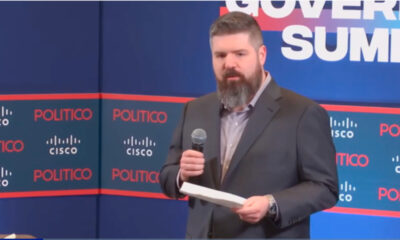
 Politics11 months ago
Politics11 months agoBlue Light News’s Editorial Director Ryan Hutchins speaks at Blue Light News’s 2025 Governors Summit
-
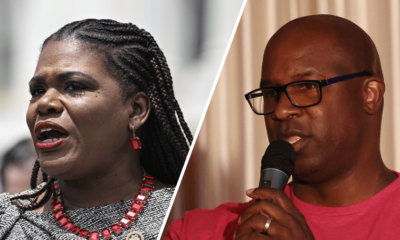
 Politics11 months ago
Politics11 months agoFormer ‘Squad’ members launching ‘Bowman and Bush’ YouTube show
-

 Politics11 months ago
Politics11 months agoFormer Kentucky AG Daniel Cameron launches Senate bid
-

 The Dictatorship11 months ago
The Dictatorship11 months agoPete Hegseth’s tenure at the Pentagon goes from bad to worse
-
Uncategorized1 year ago
Bob Good to step down as Freedom Caucus chair this week
-
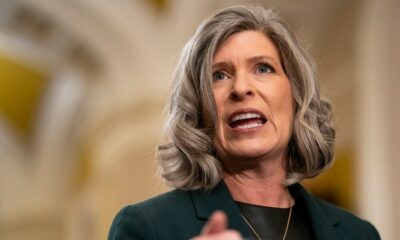
 Politics9 months ago
Politics9 months agoDemocrat challenging Joni Ernst: I want to ‘tear down’ party, ‘build it back up’




